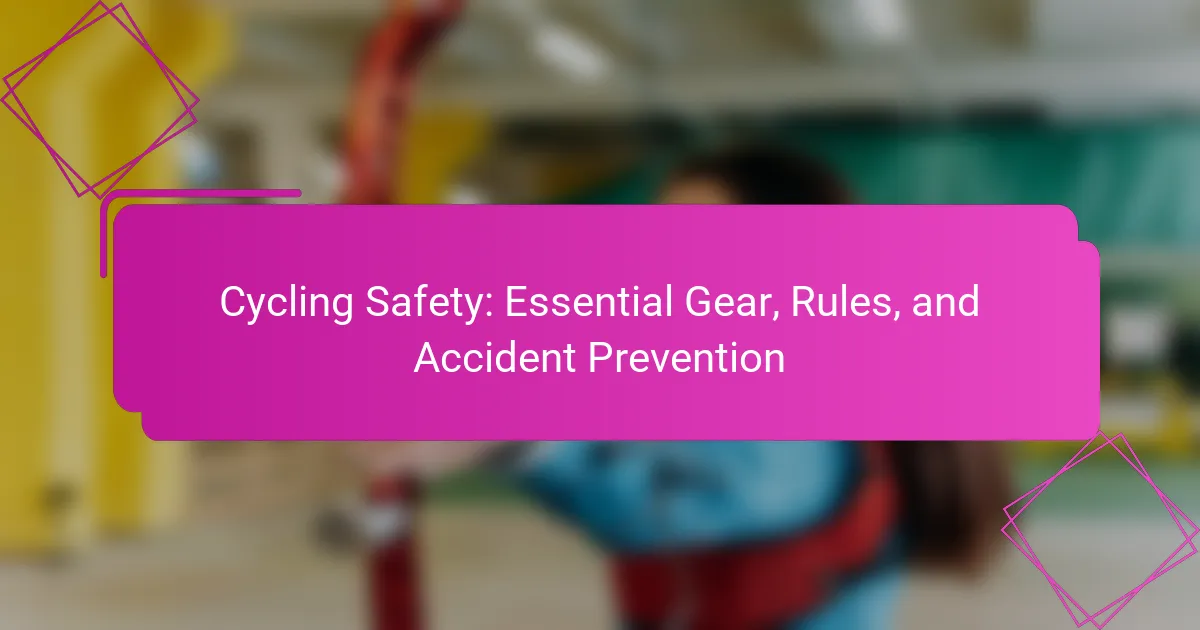Cycling safety is crucial for reducing injury risks and ensuring a secure ride. Essential gear includes helmets, reflective clothing, and lights. Following traffic rules and maintaining awareness can prevent accidents. Regular bike maintenance and using designated lanes enhance safety in urban areas.

What are the essential safety gears for cyclists?
Cyclists should wear a helmet, reflective clothing, gloves, and appropriate footwear for safety. These essential gears reduce injury risk and enhance visibility. A properly fitted helmet can decrease the likelihood of head injuries by up to 85%. Reflective clothing improves visibility in low-light conditions, while gloves provide grip and protect hands during falls. Proper footwear ensures comfort and control over the bike.
How do helmets protect cyclists?
Helmets protect cyclists by absorbing impact energy, reducing the risk of head injuries during accidents. They feature a hard outer shell that disperses force and an inner foam layer that cushions the skull. Studies show that wearing a helmet can decrease the risk of serious head injury by up to 70%. Additionally, many helmets include reflective materials for increased visibility, further enhancing safety on the road.
What are the benefits of reflective clothing?
Reflective clothing enhances visibility, significantly improving cyclist safety during low-light conditions. It reflects light from headlights, making cyclists more noticeable to drivers. This increased visibility reduces the likelihood of accidents, especially in dusk or nighttime settings. Studies show reflective gear can decrease accident rates by up to 40%. Additionally, reflective clothing often incorporates breathable materials, providing comfort during long rides.
Which lights are necessary for night cycling?
For night cycling, essential lights include a front white light, a rear red light, and reflective gear. These lights enhance visibility and safety on the road. A front light should emit at least 200 lumens for effective illumination, while a rear light should be bright enough to be seen from a distance of 500 feet. Additionally, consider using flashing modes for increased visibility.
Why are gloves important for cycling safety?
Gloves are crucial for cycling safety as they enhance grip, protect hands from injuries, and improve comfort. They minimize the risk of abrasions during falls and provide insulation in cold weather. Proper gloves can also absorb vibration, reducing fatigue during long rides. Overall, wearing gloves significantly contributes to a safer cycling experience.
How do bike locks enhance security?
Bike locks significantly enhance security by deterring theft and protecting your bicycle. A high-quality lock provides a physical barrier that makes it difficult for thieves to steal your bike. U-locks and chain locks are particularly effective due to their sturdy construction. According to studies, using a lock can reduce the risk of theft by up to 70%. Additionally, locks with advanced features, such as alarms or GPS tracking, offer unique attributes that further enhance security. Investing in a reliable bike lock is essential for any cyclist prioritizing safety.

What traffic rules should cyclists follow?
Cyclists should follow traffic rules similar to those for motor vehicles. They must obey traffic signals, ride in the same direction as traffic, and use hand signals for turns. Wearing a helmet is essential for safety, and using lights at night enhances visibility. Additionally, cyclists should avoid distractions and be aware of their surroundings.
How do road signs affect cycling safety?
Road signs significantly enhance cycling safety by providing crucial information to cyclists. They communicate rules, hazards, and directions, helping cyclists navigate roads effectively. Clear signage reduces the risk of accidents by alerting cyclists to potential dangers, such as sharp turns or pedestrian crossings. Additionally, consistent road signs foster a safer environment by promoting adherence to traffic laws. Studies indicate that areas with well-marked signs experience fewer cycling incidents, highlighting their importance in accident prevention.
What are the right-of-way rules for cyclists?
Cyclists must yield to pedestrians and follow traffic signals, treating stop signs and red lights as mandatory stops. Key right-of-way rules include yielding to vehicles on the road when in a crosswalk, and giving way to those already in the intersection. Cyclists should also be aware of bike lane regulations, which may dictate specific right-of-way protocols. Always signal turns and lane changes to enhance safety.
Why is signaling important for cyclists?
Signaling is crucial for cyclists as it enhances visibility and communication with other road users. Effective signaling reduces the risk of accidents by clearly indicating a cyclist’s intentions, such as turning or stopping. This practice promotes safer interactions with vehicles and pedestrians, ultimately decreasing the likelihood of collisions. Regular use of hand signals contributes to a more predictable riding environment, fostering safer cycling experiences.

How can cyclists prevent accidents?
Cyclists can prevent accidents by using proper safety gear, following traffic rules, and staying aware of their surroundings. Essential gear includes helmets, reflective clothing, and lights. Adhering to traffic signals and maintaining a safe distance from vehicles are crucial. Regularly checking the bike’s condition enhances safety.
What are common causes of cycling accidents?
Common causes of cycling accidents include motor vehicle collisions, poor road conditions, and cyclist negligence. Motorists often fail to see cyclists, leading to dangerous encounters. Poorly maintained roads can result in hazards like potholes or debris that cause accidents. Cyclist behaviors, such as disregarding traffic signals or riding without lights at night, also significantly contribute to accident rates. Statistics show that a high percentage of cycling accidents occur at intersections, highlighting the need for increased awareness and safety measures.
How does road awareness improve safety?
Road awareness significantly improves safety by enhancing a cyclist’s ability to anticipate and react to potential hazards. Understanding traffic patterns and being aware of surroundings reduces the likelihood of accidents. Studies show that cyclists who actively engage in road awareness practices have up to a 30% lower risk of collisions. This proactive approach fosters better communication with drivers, leading to safer interactions on the road.
What role does bike maintenance play in accident prevention?
Bike maintenance significantly reduces the risk of accidents by ensuring all components function properly. Regular checks on brakes, tires, and gears enhance safety and performance. For instance, worn tires can lead to loss of traction, increasing the likelihood of falls. A study found that 70% of cycling accidents result from mechanical failures, underscoring the importance of routine maintenance. Regularly inspecting and servicing your bike can prevent these issues and promote safer cycling experiences.

Which unique safety practices are recommended in urban areas?
Unique safety practices recommended in urban areas include wearing a helmet, using reflective gear, and following traffic signals. These measures enhance visibility and reduce accident risks. Additionally, using designated bike lanes and signaling turns can further improve cyclist safety. Regular maintenance of the bicycle ensures optimal performance and safety.
How do bike lanes contribute to cyclist safety?
Bike lanes significantly enhance cyclist safety by providing dedicated space, reducing vehicle interaction, and promoting visibility. They lower the risk of accidents by separating cyclists from motor traffic, which decreases the likelihood of collisions. Additionally, bike lanes encourage more people to cycle, leading to increased awareness among drivers. Studies show that cities with extensive bike lane networks experience lower cyclist injury rates, highlighting their importance in urban planning.
What are the challenges of cycling in heavy traffic?
Cycling in heavy traffic presents significant challenges that can impact safety. Key issues include limited visibility, aggressive drivers, and the risk of accidents. Cyclists often face distractions from surrounding vehicles and pedestrians, making it difficult to maintain focus. Additionally, navigating through tight spaces increases vulnerability to collisions. Proper gear, such as helmets and reflective clothing, enhances safety but does not eliminate risks entirely. Awareness of traffic rules and defensive riding techniques is essential for minimizing accidents.

What rare but critical safety measures should cyclists consider?
Cyclists should consider rare but critical safety measures such as using reflective gear, employing advanced helmet technology, and ensuring proper bike maintenance. Reflective gear enhances visibility in low-light conditions, significantly reducing accident risks. Advanced helmets with integrated lights and signaling features provide additional safety by increasing awareness among motorists. Regular bike maintenance, including brake checks and tire inspections, can prevent mechanical failures that lead to accidents.
How can cyclists use technology for safety enhancements?
Cyclists can enhance safety through various technologies such as smart helmets, GPS tracking, and bike lights. Smart helmets can provide hands-free communication and collision alerts. GPS devices track routes and can share real-time locations with others. Advanced bike lights improve visibility and can respond to braking. These technologies significantly reduce accident risks and improve overall cycling safety.
What are the benefits of joining cycling safety organizations?
Joining cycling safety organizations provides numerous benefits. These groups enhance safety awareness, offer training programs, and advocate for better cycling infrastructure. Members gain access to resources, expert advice, and community support. Additionally, participation fosters a sense of camaraderie among cyclists, promoting a safer riding environment. Engaging with these organizations can lead to improved cycling skills and confidence on the road.

What expert tips can improve cycling safety?
To improve cycling safety, wear a helmet, use lights, and follow traffic rules. Ensuring visibility and adhering to regulations significantly reduces accident risk.
1. Always wear a properly fitted helmet to protect your head.
2. Use front and rear lights, especially at night or in low visibility.
3. Follow traffic signals and signs to maintain safe riding practices.
4. Stay alert and avoid distractions while cycling.
5. Use designated bike lanes whenever available to enhance safety.
6. Regularly maintain your bicycle to ensure it is in good working condition.
What common mistakes do cyclists make regarding safety?
Common mistakes cyclists make regarding safety include neglecting to wear helmets, failing to signal turns, riding without lights at night, and ignoring traffic rules. These oversights increase the risk of accidents and injuries. Proper gear, like reflective clothing and functioning lights, is essential for visibility. Additionally, cyclists often underestimate the importance of maintaining their bikes, which can lead to mechanical failures. Regular inspections and proper maintenance can significantly enhance safety on the road.
How can cyclists stay informed about safety regulations?
Cyclists can stay informed about safety regulations by regularly checking local transportation department websites and joining cycling advocacy groups. These sources provide updates on laws and safety initiatives. Additionally, subscribing to cycling newsletters and following social media channels dedicated to cycling safety can enhance awareness. Engaging with local cycling communities also fosters knowledge sharing about best practices and recent changes in regulations.
What best practices should cyclists adopt for safer rides?
Cyclists should adopt several best practices for safer rides, including wearing a helmet, using lights, and following traffic rules. Prioritize visibility by wearing bright clothing and using reflective gear. Regularly inspect your bike for mechanical issues to prevent accidents. Always signal turns and stops to communicate with drivers.
